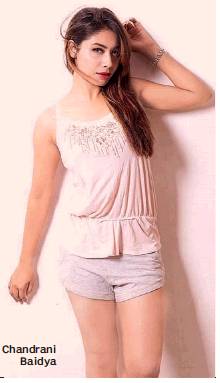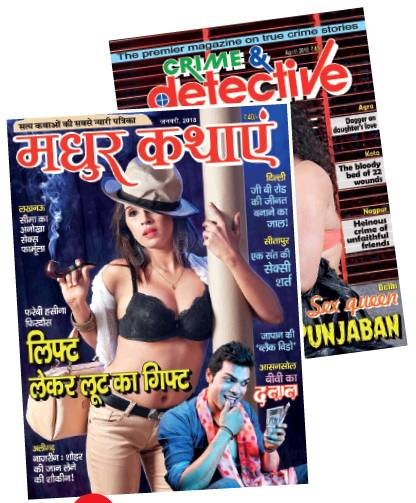Madhur Kathayein/ Crime and Detective
This is a collection of articles archived for the excellence of their content. |
1986 onwards
Himanshi Dhawan, WHEN TITILLATION MEETS TRUE CRIME, September 16, 2018: The Times of India
With its hot and heady cocktail of sex and crime reporting, one print mag has survived and thrived for over three decades
Long before dramatised crime shows on TV became a rage, small-town India’s sex and crime games were being captured in ‘graphic’ graphic-novel style in Madhur Kathayein, and later its English version, Crime and Detective. With headlines like ‘Pakhandi babaon ki vasna gatha’, ‘Ek thi Sheela, hawas ki leela’, ‘Aasteen mein palne wali hawas ki nagin’ and pictures of busty women in slipping pallus and thunder thighs on the cover, it wasn’t difficult to figure out why these crime mags found readers in the pre-YouTube era.
But Madhur Kathayein, which started in 1986, is not just one of the longest running sex-crime magazines in India; it still sells about a lakh copies a month, and has a strong fan following across north India. Crime and Detective, the English magazine, sells 40,000-50,000 copies a month, largely in the North-East. The revenue for these magazines is driven by newsstand sales.
So what’s the secret to its longevity in an age where porn is available on every phone? Editor Shailabh Rawat says it’s because the stories give the lower middleclass and lower class a voyeuristic look into how the upper class lives. “There is a curiosity about wife-swapping, gigolo parties and homosexuality and we provide them a glimpse of that life,’’ he says. His publishing house Nai Sadi Prakashan has a bouquet of health and women’s interest magazines but the most popular is Madhur Kathayein that is hawked at railway stations and pavement book-sellers for Rs 40.
Rawat, who is from Ranikhet in Uttarakhand, fell into writing on sex and crime by chance. He came to Delhi to prepare for the civil services exam in 1983 but soon found a job at Delhi Press’ women’s magazine Sarita. Later, Rawat joined Nai Sadi Prakashan and turned his attention to crime. “Newspapers and TV channels only touch the surface of a crime. We go into the human emotions, the conditions that led to the crime,’’ says the 60-year-old.
There seems to be no dearth of it in smalltown India, and Rawat has 25 reporters who file crime news from across the country. Real-life cases like the Pilibhit family that sacrificed a young girl to dispel evil spirits under the spell of a fake godman, or the woman who posed as a man to befriend and marry other women are fictionalised. Then there are stories about Jalebi baba in Haryana who moved up in life from a sweet-maker to a tantrik. The fake godman would drug women, film them and use the CDs to blackmail them. The magazine often captures murders committed in a jealous rage, or bosses forcing sex on women employees.
Though the women are there to titillate, Rawat feels the magazine’s hot and heavy script has a strong social message and a happy ending. “Every article has a lesson, either warning girls not to fall for sweet talk by a stranger or showing how she can turn the tables by taking charge of the situation,’’ he says. So in one article, the girl foils a plan to sell her to a pimp by poisoning her devious boyfriend and his pal, while in another the girl shows a lecherous filmmaker the door instead of succumbing to the casting couch.
Over the years, the magazine, has captured the phenomenon of libidinous godmen, proliferation of orchestra parties and massage parlours, with little competition, in its signature style: the photo story.
The photo story is definitely the magazine’s USP but it’s quite a job on shoe-string budgets. Rawat the editor turns into a shoot coordinator, finding aspiring models or theatre actors to play the lead roles, supervising lighting, photography, make-up, and even acting out scenes to give the actor cues. A small bench in his Nai Sadi office in Delhi’s Mukherjee Nagar is transformed with inventive use of fake greenery, colourful bedsheets and curtains, which artfully hide some private parts. He then selects the photographs and writes the script. The wordsmith can churn out dialogues like “Doctor, why are you delaying! My body is charging with heat, so squeeze that heat out of my body.’’ The woman mouths these lines while writhing on a bed, even as her partner in crime and sister-inlaw film them so that they can blackmail the physician later.
Rajesh Dua, who is also a TV actor and has donned the role of an inspector, doctor or even a killer for photo story, is quite candid about the need for ‘masala’ on the cover. “Logon ko ankhen sekne ke liye kuch to chahiye (people need something to look at),” he says.
TV actor Chandrani Baidya adds, “This is the hypocrisy in India. We talk about sanskriti aur sabhyata (culture and traditions), but we all want to watch Sunny Leone.’’
The cover girls
MEET THE BOLD COVER GIRLS, September 16, 2018: The Times of India

From: MEET THE BOLD COVER GIRLS, September 16, 2018: The Times of India
A Madhur Kathayein photo story model, equipped with costumes and a lack of inhibitions, can earn between Rs 3,000-Rs 7,000. But more than the cash, the magazine’s popularity can open doors of opportunity in the entertainment industry, whether it is TV crime shows, Bhojpuri films or advertisements. Though of course, the aspiring actors, struggling models and even some desperate housewives hope that it will translate into a much-desired Bollywood break.
Twenty-six year-old Chandrani Baidya says her cover shoot got her a call for a Rakhi Sawant show because the writers felt she could handle ‘bold content’. Baidya, who has moved on to TV and film says, ‘’After my first cover, I didn’t know whether to show the magazine to my parents or not. I finally did, after tearing some pages.’’ Baidya says the parental opposition reduced only after she got a break on TV but admits that adult shoots are not for everyone. When auditioning for TV roles, Baidya found that letting people know about the adult shoots was a nuisance. “People thought if I had done such a shoot, I was comfortable with everything,’’ she says.
For 44-year-old Anju Thakur, the shift from school teacher to theatre actor to cover girl has been a long journey. Initially even other artistes dissuaded her from doing the shoot. But she argues, ‘’If I act as a beggar, do I become a beggar? So as an artiste I am happy to do all work and the photo story is no different.’’
